A Joint Sedimentation-Flood Retention Assessment of a Small Water Reservoir in Slovakia: A New Hope for Old Reservoirs?
Abstract
1. Introduction
2. Materials and Methods
2.1. Study Area
2.2. Bathymetric Survey of the Small Water Reservoir
2.3. Modeling the Sedimentation in the Reservoir
2.4. Modeling the Attenuation of a Flood Hydrograph
3. Results
3.1. Sedimentation of the Vrbovce SWR
3.2. Transformation of the 100-Year Flood Wave
4. Discussion
4.1. Monitoring Approach and Its Uncertainties
4.2. Modeling Approach and Its Uncertainties
4.3. Vrbovce SWR—Results and Implications
5. Conclusions
Author Contributions
Funding
Conflicts of Interest
References
- Woods, R. Hydrologic Concepts of Variability and Scale. In Encyclopedia of Hydrological Sciences; Anderson, M.G., Ed.; John Wiley and Sons: Chichester, UK, 2005; pp. 23–40. ISBN 0-471-49103-9. [Google Scholar]
- Šoltísová, A. Stav malých vodných nádrží v povodí rieky Bodrog [State of small water reservoirs in the river basin Bodrog]. In Proceedings of the XXXIV. Priehradné dni 2014, Horný Smokovec, Slovakia, 24–26 June 2014; pp. 1–7. (In Slovak). [Google Scholar]
- Janeczko, E. The role and importance of forest watercourses and water reservoirs in designing landscape values of forests. J. Water Land Dev. 2009, 13, 177–185. [Google Scholar] [CrossRef]
- Kondolf, G.M.; Gao, Y.; Annandale, G.W.; Morris, G.L.; Jiang, E.; Zhang, J.; Cao, Y.; Carling, P.; Fu, K.; Guo, Q.; et al. Sustainable sediment management in reservoirs and regulated rivers: Experiences from five continents. Earth’s Future 2014, 2, 256–280. [Google Scholar] [CrossRef]
- Annandale, G.W. Reservoir Sedimentation. In Encyclopedia of Hydrological Sciences; Anderson, M.G., Ed.; John Wiley and Sons: Chichester, UK, 2005; pp. 1327–1339. ISBN 0-471-49103-9. [Google Scholar]
- Cunha, D.G.F.; Benassi, S.F.; de Falco, P.B.; Calijuri, M.C. Trophic State Evolution and Nutrient Trapping Capacity in a Transboundary Subtropical Reservoir: A 25-Year Study. Environ. Manag. 2016, 57, 649–659. [Google Scholar] [CrossRef]
- Kondolf, G.M. Hungry Water: Effects of Dams and Gravel Mining on River Channels. Environ. Manag. 1997, 21, 533–551. [Google Scholar] [CrossRef]
- Vanmaercke, M.; Poesen, J.; Verstraeten, G.; de Vente, J.; Ocakoglu, F. Sediment yield in Europe: Spatial patterns and scale dependency. Geomorphology 2011, 130, 142–161. [Google Scholar] [CrossRef]
- White, R. Evacuation of Sediments from Reservoirs; Thomas Telford: London, UK, 2001; p. 280. ISBN 978-0727729538. [Google Scholar]
- Palmieri, A.; Shad, F.; Annandale, G.W.; Dinar, A. Reservoir Conservation: The RESCON Approach; 34954; The World Bank: Washington, DC, USA, 2003; p. 102. [Google Scholar]
- Annandale, G.W.; Morris, G.L.; Karki, P. Extending the Life of Reservoirs: Sustainable Sediment Management for Dams and Run-of-River Hydropower; The World Bank: Washington, DC, USA, 2016; p. 191. ISBN 978-1-4648-0837-1. [Google Scholar]
- Sumi, T.; Kantoush, S.A.; Suziki, S. Performance of Miwa Dam Sediment Bypass Tunnel: Evaluation of Upstream and Downstream State and Bypassing Efficiency. In Proceedings of the 24th ICOLD Congress, Kyoto, Japan, 6–8 June 2012; pp. 576–596. [Google Scholar]
- Morris, G.L. Offstream Reservoirs for Sustainable Water Supply in Puerto Rico. In Proceedings of the American Water Resources Association 2010 Summer Specialty Conference, San Juan, Puerto Rico, 31 August–1 September 2010. [Google Scholar]
- Kostaschuk, R.; Best, J.; Villard, P.; Peakall, J.; Franklin, M. Measuring flow velocity and sediment transport with an acoustic Doppler current profiler. Geomorphology 2005, 68, 25–37. [Google Scholar] [CrossRef]
- Yutsis, V.; Krivosheya, K.; Levchenko, O.; Lowag, J.; de León Gómez, H.; Tamez Ponce, A. Bottom topography, recent sedimentation and water volume of the Cerro Prieto Dam, NE Mexico. Geofís. Int. 2014, 53, 27–38. [Google Scholar] [CrossRef]
- Sočuvka, V.; Ivan, P.; Hlavčová, K.; Kohnová, S.; Velísková, Y. Analýza zanášania poldra Svacenický jarok [Clogging analysis of the polder Svecenický jarok]. Acta Hydrol. Slovaca 2016, 17, 117–124. (In Slovak) [Google Scholar]
- White, S. Sediment Yield Prediction and Modeling. In Encyclopedia of Hydrological Sciences; Anderson, M.G., Ed.; John Wiley and Sons: Chichester, UK, 2005; pp. 1315–1326. ISBN 0-471-49103-9. [Google Scholar]
- Dutta, S. Soil erosion, sediment yield and sedimentation of reservoir: A review. Model. Earth Syst. Environ. 2016, 2, 123. [Google Scholar] [CrossRef]
- Zhang, X.; Wu, S.; Cao, W.; Guan, J.; Wang, Z. Dependence of the sediment delivery ratio on scale and its fractal characteristics. Int. J. Sediment Res. 2015, 30, 338–343. [Google Scholar] [CrossRef]
- Brown, C.B. Discussion of sedimentation in reservoirs. Trans. Am. Soc. Civ. Eng. 1943, 69, 1493–1500. [Google Scholar]
- Brune, G.M. Trap efficiency of reservoirs. Eos Trans. Am. Geophys. Union 1953, 34, 407. [Google Scholar] [CrossRef]
- Churchill, M.A. Discussion of Analysis and Use of Reservoir Sedimentation Data. In Proceedings of the Federal Inter-Agency Sedimentation Conference, Denver, CO, USA, 6–8 May 1947; pp. 139–140. [Google Scholar]
- Jurík, Ľ.; Húska, D.; Sedmáková, M. Malé vodné nádrže v SR - ohrozený zdroj vody pre závlahy? [Small water reservoirs in Slovakia - threattened source of water for irrigation?]. In Proceedings of the Závlahy a jejich perspektiva, Mikulov, Czech Republic, 18–19 March 2015; pp. 1–12. (In Slovak). [Google Scholar]
- Korbeľová, L.; Kohnová, S. Methods for Improvement of the Ecosystem Services of Soil by Sustainable Land Management in the Myjava River Basin. Slovak J. Civ. Eng. 2017, 25, 29–36. [Google Scholar] [CrossRef]
- Hrabovský, O. Budúcnosť malých vodných nádrží na Východnom Slovensku [The future of small water reservoirs in Eastern Slovakia]. In Proceedings of the XXXIV. Priehradné dni 2014, Horný Smokovec, Slovakia, 24–26 June 2014; pp. 1–8. (In Slovak). [Google Scholar]
- Stankoviansky, M. Antropogénne zmeny krajiny myjavskej kopaničiarskej oblasti [Anthropic Transformations of Landscape in the Myjava Kopanitse Region]. Životn. Prostr. 1997, 31, 84–89. (In Slovak) [Google Scholar]
- Stankoviansky, M. Erózia z orania a jej geomorfologický efekt s osobitým zreteľom na myjavsko-bielokarpatskú kopaničiarsku oblasť [Tillage erosion and its geomorphic effect with special regard to the Myjava-White Carpathian kopanitse area]. Geogr. Čas. 2001, 53, 95–110. (In Slovak) [Google Scholar]
- Valent, P.; Rončák, P.; Maliariková, M.; Behan, Š. Utilization of Historical Maps in the Land Use Change Impact Studies: A Case Study from Myjava River Basin. Slovak J. Civ. Eng. 2016, 24, 15–26. [Google Scholar] [CrossRef]
- Stankoviansky, M. Historical evolution of permanent gullies in the Myjava Hill Land, Slovakia. CATENA 2003, 51, 223–239. [Google Scholar] [CrossRef]
- Teledyne RD Instruments. StreamPro ADCP: Operational Manual; Teledyne RD Instruments: Poway, CA, USA, 2008; p. 118. [Google Scholar]
- Mueller, D.S.; Wagner, C.R.; Rehmel, M.S.; Oberg, K.A.; Rainville, F. Measuring Discharge with Acoustic Doppler Current Profilers from a Moving Boat; U.S. Geological Survey: Reston, VA, USA, 2009; p. 72.
- Czuba, J.A.; Olsen, T.D.; Czuba, C.R.; Magirl, C.S.; Gish, C.C. Changes in Sediment Volume in Alder Lake, Nisqually River Basin, Washington, 1945–2011; U.S. Geological Survey: Reston, VA, USA, 2012; p. 30.
- Wischmeier, W.H.; Smith, D.D. Predicting Rainfall Erosion Losses: A Guide to Conservation Planning; USDA-SEA: Washington, DC, USA, 1978; p. 58.
- Kinnell, P.I.A. Sediment delivery ratios: A misaligned approach to determining sediment delivery from hillslopes. Hydrol. Process. 2004, 18, 3191–3194. [Google Scholar] [CrossRef]
- Alena, F. Protierózna Ochrana na ornej pôde [Soil Erosion Protection]; Štátna Melioračná Správa: Bratislava, Slovakia, 1991; p. 191. (In Slovak) [Google Scholar]
- Van Ost, K.; Govers, G. USLE2D: Online Manual. 2000. Available online: https://ees.kuleuven.be/geography/modeling/usle2dhome/ (accessed on 2 April 2019).
- McCool, D.K.; Foster, G.R.; Mutchler, C.K.; Meyer, L.D. Revised slope length factor for the Universal Soil Loss Equation. Trans. ASAE 1989, 32, 1571–1576. [Google Scholar] [CrossRef]
- Nearing, M.A. A Single, Continuous Function for Slope Steepness Influence on Soil Loss. Soil Sci. Soc. Am. J. 1997, 61, 917–919. [Google Scholar] [CrossRef]
- McCool, D.K.; Brown, L.C.; Foster, R.; Mutchler, C.K.; Meyer, L.D. Revised Slope Steepness Factor for the Universal Soil Loss Equation. Trans. ASAE 1987, 30, 1387–1396. [Google Scholar] [CrossRef]
- Malíšek, A. Optimálna dĺžka svahu v závislosti na vodnej erózii [Optimal Length of Hillslope Related to Water Erosion]; Výskumný ústav pôdnej úrodnosti: Bratislava, Slovakia, 1992; pp. 203–220. (In Slovak) [Google Scholar]
- Williams, J.R. Sediment delivery ratios determined with sediment and runoff models. In Proceedings of the International Symposium on Erosion and Soil Matter Transport in Inland Waters, Paris, France, 4–8 July 1997; pp. 168–179. [Google Scholar]
- Krasa, J.; Dostal, T.; Van Rompaey, A.; Vaska, J.; Vrana, K. Reservoirs’ siltation measurments and sediment transport assessment in the Czech Republic, the Vrchlice catchment study. CATENA 2005, 64, 348–362. [Google Scholar] [CrossRef]
- Ouyang, D.; Bartholic, J. Predicting Sediment Delivery Ratio in Saginaw Bay Watershed. In Proceedings of the 22nd National Association of Environmental Professionals Conference, Orlando, FL, USA, 19–23 May 1997; pp. 659–671. [Google Scholar]
- Mishra, S.K.; Singh, V. Soil Conservation Service Curve Number (SCS-CN) Methodology; Springer: Dordrecht, The Netherlands, 2003; p. 516. ISBN 978-1-4020-1132-0. [Google Scholar]
- Menon, E.S. Piping Calculations Manual; McGraw-Hill: New York, NY, USA, 2005; p. 666. ISBN 0-07-144090-9. [Google Scholar]
- Mäsiar, E.; Kamenský, J. Hydraulika II [Hydraulics II], 3rd ed.; Vydavateľstvo STU v Bratislave: Bratislava, Slovakia, 2001; p. 319. ISBN 80-227-1487-9. (In Slovak) [Google Scholar]
- Mäsiar, E.; Kamenský, J. Hydraulika pre Stavebných Inžinierov I [Hydraulics for Civil Engineers I]; ALFA: Bratislava, Slovakia, 1985; p. 344. ISBN 63-058-86. (In Slovak) [Google Scholar]
- Khatsuria, R.M. Hydraulics of Spillways and Energy Dissipators, 1st ed.; CRC Press: Boca Raton, FL, USA, 2004; p. 680. ISBN 978-0-203-99698-0. [Google Scholar]
- Landscape Atlas of the Slovak Republic, 1st ed.; MŽP SR: Bratislava, Slovakia, 2002; p. 342. ISBN 80-88833-27-2.
- Výleta, R.; Valent, P.; Danáčová, M. Utilization of an existing multipurpose small water reservoir in reducing flood flows. In Proceedings of the 17th International Multidisciplinary Scientific GeoConference SGEM 2017, Vienna, Austria, 27–29 November 2017; pp. 431–438. [Google Scholar]
- Simpson, M.R. Discharge Measurements Using a Broad-Band Acoustic Doppler Current Profiler; U.S. Geological Survey: Sacramento, CA, USA, 2001; p. 134.
- Salas, J.D.; Shin, H.-S. Uncertainty Analysis of Reservoir Sedimentation. J. Hydraul. Eng. 1999, 125, 339–350. [Google Scholar] [CrossRef]
- Panagos, P.; Borrelli, P.; Meusburger, K. A New European Slope Length and Steepness Factor (LS-Factor) for Modeling Soil Erosion by Water. Geosciences 2015, 5, 117–126. [Google Scholar] [CrossRef]
- Goudie, A.S. (Ed.) Encyclopedia of Geomorphology; Routledge: London, UK, 2004; p. 1156. ISBN 0-415-32738-5. [Google Scholar]
- Post, D.A.; Hartcher, M.G. Evaluating uncertainty in modeled sediment delivery in data sparse environments: Application to the Mae Chaem catchment, Thailand. In Prediction in Ungauged Basins: Promises and Progress; Sivapalan, M., Wagener, T., Uhlenbrook, S., Zehe, E., Lakshmi, V., Liang, X., Tachikawa, Y., Kumar, P., Eds.; IAHS Press: Wallingford, UK, 2006; pp. 80–89. ISBN 1-901502-48-1. [Google Scholar]
- Beven, K.J.; Brazier, R.E. Dealing with Uncertainty in Erosion Model Predictions. In Handbook of Erosion Modeling; Morgan, R.P.C., Nearing, M.A., Eds.; John Wiley & Sons: Chichester, UK, 2010; ISBN 978-1-4051-9010-7. [Google Scholar]
- Swarnkar, S.; Malini, A.; Tripathi, S.; Sinha, R. Assessment of uncertainties in soil erosion and sediment yield estimates at ungauged basins: an application to the Garra River basin, India. Hydrol. Earth Syst. Sci. 2018, 22, 2471–2485. [Google Scholar] [CrossRef]
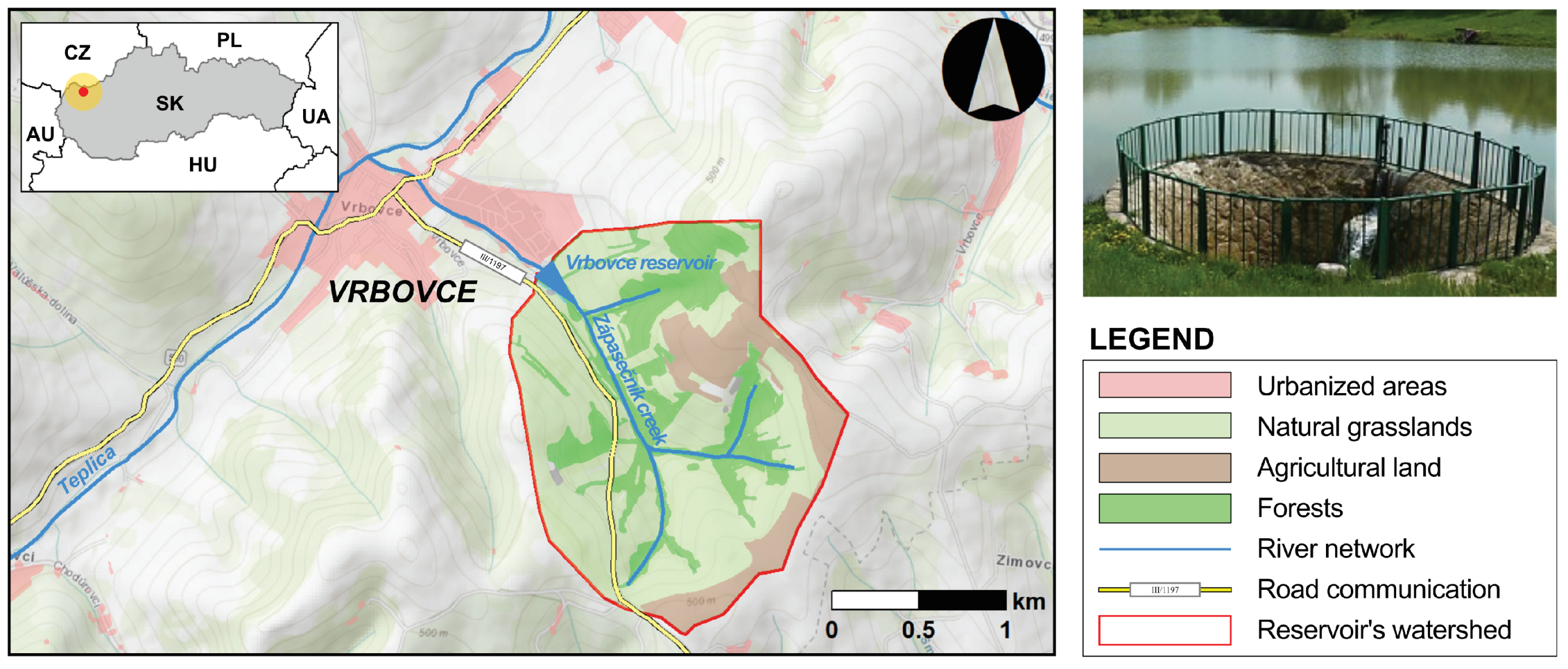

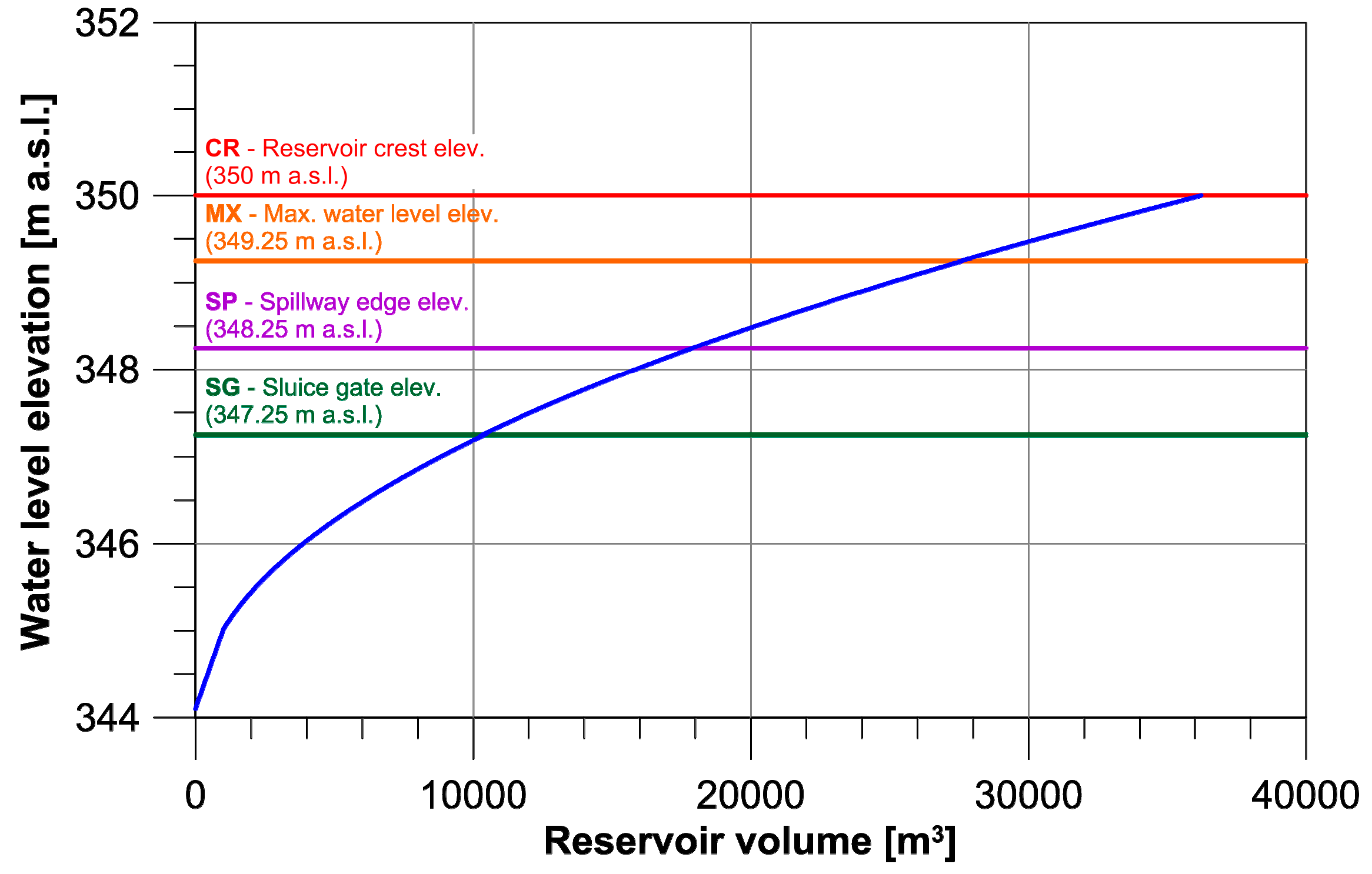
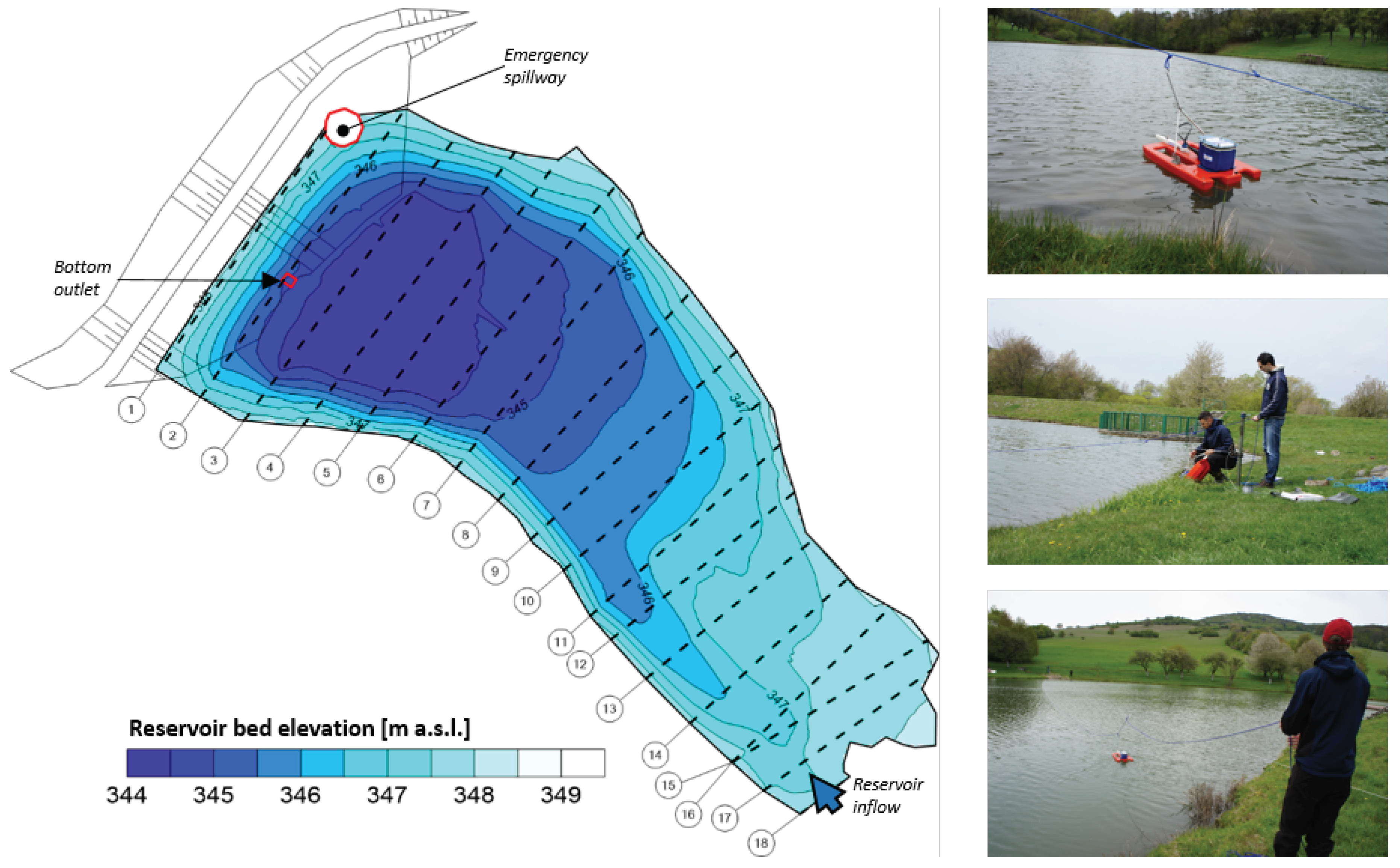

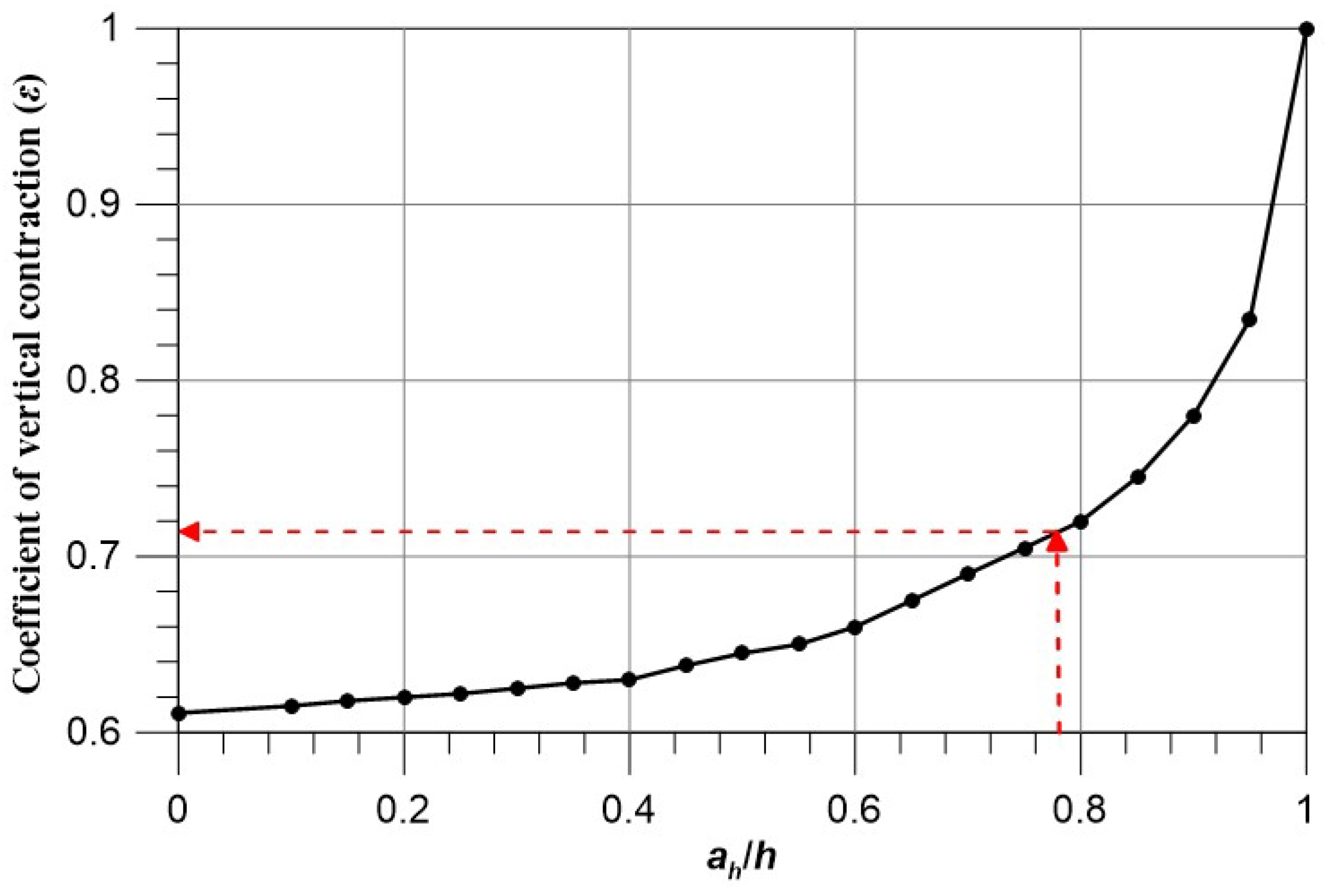
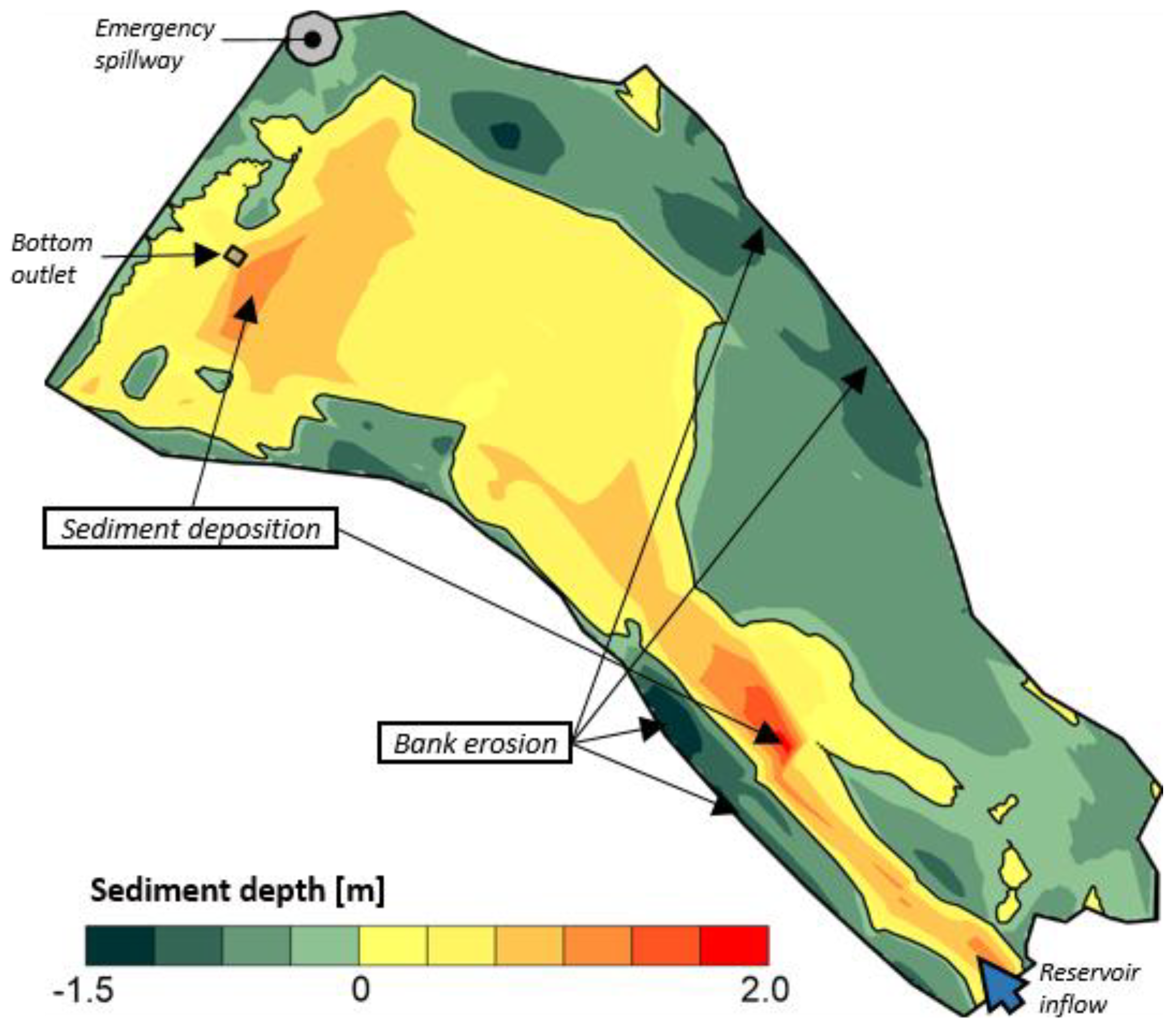

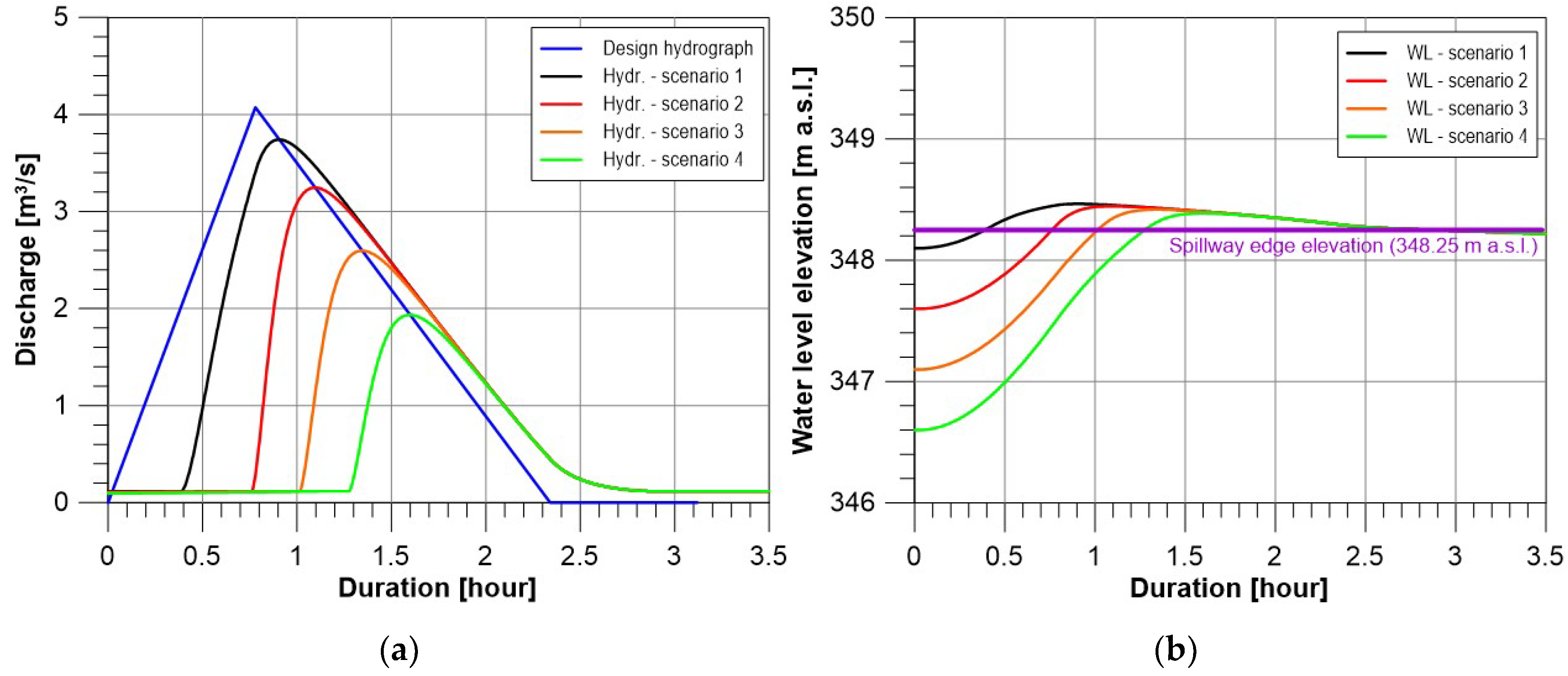
| Initial. WL (m a.s.l.) | Qout,max (m3/s) | Max WL (m a.s.l) | Transformation Effect (%) | Delay (min) | |
|---|---|---|---|---|---|
| Scenario 1 | 348.1 | 3.74 | 348.46 | 8.1 | 7.5 |
| Scenario 2 | 347.6 | 3.25 | 348.45 | 20.3 | 18.8 |
| Scenario 3 | 347.1 | 2.59 | 438.42 | 36.2 | 33.8 |
| Scenario 4 | 346.6 | 1.93 | 348.39 | 52.5 | 49.0 |
| Method for Estimating Reservoir’s Sedimentation | TS (m3) | MASR (m3/year) | DIFF (%) |
|---|---|---|---|
| Monitoring | 334.0 | 41.7 | - |
| Modeling—with the area above the road | 408.8–614.1 | 51.1–76.8 | +22% to +84% |
| Modeling—without the area above the road | 300.0–445.6 | 37.5–55.7 | −10% to +33% |
© 2019 by the authors. Licensee MDPI, Basel, Switzerland. This article is an open access article distributed under the terms and conditions of the Creative Commons Attribution (CC BY) license (http://creativecommons.org/licenses/by/4.0/).
Share and Cite
Valent, P.; Výleta, R.; Danáčová, M. A Joint Sedimentation-Flood Retention Assessment of a Small Water Reservoir in Slovakia: A New Hope for Old Reservoirs? Geosciences 2019, 9, 158. https://doi.org/10.3390/geosciences9040158
Valent P, Výleta R, Danáčová M. A Joint Sedimentation-Flood Retention Assessment of a Small Water Reservoir in Slovakia: A New Hope for Old Reservoirs? Geosciences. 2019; 9(4):158. https://doi.org/10.3390/geosciences9040158
Chicago/Turabian StyleValent, Peter, Roman Výleta, and Michaela Danáčová. 2019. "A Joint Sedimentation-Flood Retention Assessment of a Small Water Reservoir in Slovakia: A New Hope for Old Reservoirs?" Geosciences 9, no. 4: 158. https://doi.org/10.3390/geosciences9040158
APA StyleValent, P., Výleta, R., & Danáčová, M. (2019). A Joint Sedimentation-Flood Retention Assessment of a Small Water Reservoir in Slovakia: A New Hope for Old Reservoirs? Geosciences, 9(4), 158. https://doi.org/10.3390/geosciences9040158




